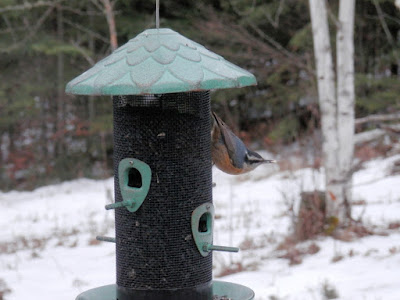 |
| Evening Grosbeak, a parrot-like finch |
 |
| Hairy Woodpecker |
 |
| Black-capped Chickadee |
 |
| Common Loon (Photo by Bob Preuss) |
 |
| Goldfinch |
 |
| Red-breasted Nuthatch |
 |
| Grey Jay |
 |
| Blue Jay |
 |
| Pine Grosbeak |
 |
| White-throated Sparrow |
Readers could vote for their favorite feathered icon. The overwhelming response, and I might say, the obvious choice, was the Common Loon. It is already the iconic bird on our $1 coin -- the Loonie -- and its wonderful and eerie calls are a symbol of wilderness. If Canada is anything, it is the country that identifies the most with the wild. You know you are in Canada when you see or hear a loon. The bird decision seemed like a no-brainer.
Much to everybody's surprise, the magazine instead chose the Grey Jay, once called the Canada Jay, but known by everyone in the North as the Whisky Jack.
The magazine perhaps anticipated there might be a backlash to its choice so it gave an explanation. The Loon migrates south in the winter (the turncoat!) and it already is a provincial bird -- Ontario's.
So the magazine chose the Grey Jay which it points out is found throughout the Boreal Forest and stays year-around. It is extremely friendly and will eat right out of your hand. It also has a large brain for its body size and it caches its food.
The magazine didn't tell the complete story about the Whisky Jack, however. For instance, you may never see one in an entire summer since they are quite reclusive in the warm months. You will also absolutely never see one, even in the winter, in those parts of Canada that aren't in the Boreal Forest, like Southern Ontario where about 50 per cent of the population resides.
So basically we are picking as our national bird one that most people will never see in their lives.
Does this make any sense? Couldn't the national bird also be Ontario's provincial bird?
And should we think less of a bird because it goes south in the winter? You could hardly ask the loon to stay. It spends its entire life on the water and that gets mighty stiff each winter. So it heads to Florida where it lounges around in the Atlantic and the Gulf. In other words, it does the same thing as about one-third of human Canadians.
Don't get me wrong, I admire Whisky Jacks and their friendly ways. They are regular visitors to the suet at our bird feeder here in Nolalu. I'll add a superlative about this bird that the magazine forgot. It is the slowest flier of all Canadian birds. As it glides around the understory of the bush it can just about stop mid-air without moving its wings. It seems like it is defying gravity.
Chickadees are just as friendly or maybe just as fearless. They also are smart and if it matters, also cache food. So does the Blue Jay.
If we're going for smarts, then we absolutely should make the raven the national bird. I'm convinced that ravens are at least as smart as people and I think a whole lot wiser.
But if we really do end up with the Grey Jay, then let us go back to calling it the Canada Jay.
All the photos above, with the exception of the nesting Common Loon which was taken by Bow Narrows angler Bob Preuss, came from our bird feeder this early winter in Nolalu. It has been a spectacular year for attracting birds. The White-throated Sparrow photo was taken in late-November which is remarkable because this bird normally migrates south in August.
Click to go back to our website
Click to see the latest on the blog


3 comments:
My Father told me that when he was younger (born 1909). There were loons on the Ohio River here near Cincinnati. He tried shooting some, never got one, and he was an excellent shot!
That's really interesting. From what I know today there are only loons in the most northern states and in Canada. I should note that they are all protected from hunting under the Migratory Birds Act.
Dad always swore that they ducked! No pun intended! This was back in the 20's
Post a Comment